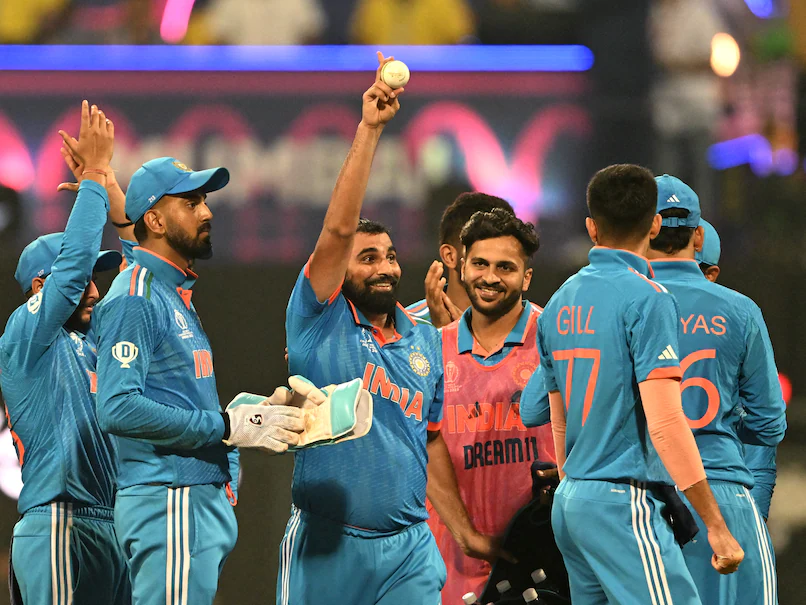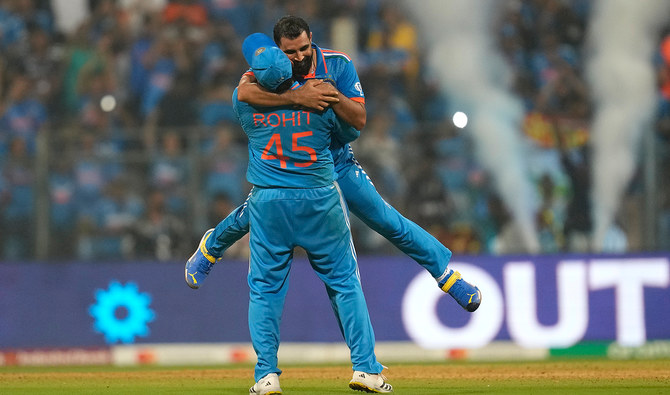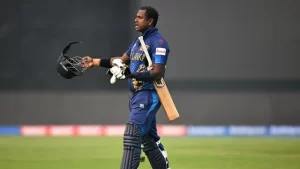Shami Makes History, Becomes India’s Top World Cup Wicket-Taker

Mohammed Shami in action for the Indian cricket team during Cricket World Cup 2023
The Sri Lankan cricket team remained huddled in their dressing room long after the match had ended, the crowds had departed, and the lights at the Wankhede Stadium had been switched off. A security guard at the main gate, whose tone was filled with anger and frustration, speculated that they must be “licking their fresh wounds.” The guard’s restlessness was understandable, as he had been waiting to go home after a long day’s work.
The Sri Lankan players in the dressing room were unaware of the situation of the guards outside the stadium. The guards’ workday had been cut in half, and they had all the time in the world to contemplate the devastation they had suffered at the hands of the Indian bowlers.
Before they could even react, the combined power of India’s pace trio of Jasprit Bumrah, Mohammed Siraj, and Mohammed Shami had orchestrated a complete demolition of their batting order, by an incredibly wide margin of 302 runs.
The Sri Lankan team needed time to regroup and process their devastating defeat, which exposed the harsh reality that the Asia Cup final meltdown was not a one-off collapse. They had no answer to the marauding Indian pacers, and their surrender on Thursday was meek and pathetic. Their batting could not even last 20 overs, highlighting the desperate need for improvement.
For the Sri Lankan batsmen, it must have felt like a Zugzwang situation—every move they made led them into a deadly trap. If they somehow survived the swing, seam, and bounce of Bumrah, they had to face the relentless Siraj, who chased them down like a bull after a red rag. And if they overcame Siraj, there was the sheer power and accuracy of Shami, waiting to pounce on them like a lion in the African jungle.
It was like an escape from one predator, only to be confronted by another—like running from a frying pan, only to fall into the fire. If Bumrah missed, Siraj wouldn’t; if Siraj missed, Shami wouldn’t. All three bowlers were relentless, consistently bowling over 140 kph and rattling the Lankan batsmen, who had five ducks, three single-digit scores, and three double-digit runs. As Lanka’s batting coach Naveed Nawaz would later confess, none of their team members were able to step back and effectively manage the situation.
The demolition of the Sri Lankan batting lineup began with the very first ball of the innings, when Bumrah trapped Pathum Nissanka in front of the stumps for a golden duck. The opener, rooted to the spot by the incoming delivery, could only watch as the ball swung away and clipped his nails. It was a major blow for a side chasing a formidable target of 358.
Siraj, following Bumrah’s lead, struck with his very first ball, trapping Dimuth Karunaratne plumb in front with a bullet of a delivery. Another golden duck! He needed only four more deliveries to induce an edge from Sadeera Samarawickrama, securing two wickets in his very first over.
Siraj claimed his third scalp in the form of skipper Kusal Mendis, who was cleaned up by a lightning bolt of a delivery. By that stage, Sri Lanka had lost more wickets than they had managed to score runs—2/3.
Shami too joined the demolition party, striking in his first over, the ninth of the innings, to have Charith Asalanka caught at point by Ravindra Jadeja. He made it two in two by having Dushan Hemantha caught behind. By then, Sri Lanka were reeling at 14 for six and were in danger of being bowled out for less than 20 runs. They managed to surpass 50 runs, but not before Shami had claimed his five-for and completed their capitulation in 19.4 overs.
The Indian bowling possessed power, precision, penetration, punch, and panache. It was reminiscent of the great pace combinations of the past, such as Malcolm Marshall, Andy Roberts, and Michael Holding, or Glenn McGrath, Jason Gillespie, and Brett Lee, who would terrorize batsmen. The Sri Lankans were clearly left scarred by the experience in the middle, blown away by the sheer power and pace of the Indian bowling attack.
Though all three Indian bowlers were right-armers, they were diametrically opposed, like ice and fire, or water and oil. One relied on movement, another on raw pace, and the third on precision. The combined effect was devastating, with each delivery a thunderbolt.
“All three maintained unwavering accuracy in their line, making them extremely difficult to handle,” noted Dilshan Madushanka, who himself had a five-wicket haul in the match.
Shreyas Iyer described watching the Indian bowling attack as a surreal experience. “It’s hard to say, because I was sitting out in the Asia Cup final, but from the outside, it looked different. Now, playing on the field, I felt that today’s performance was surreal, especially of the bowlers, and the way they stood up to the occasion. Once we got those two-three wickets, we just capitalized on that. And as a bowling and fielding unit, we supported our bowlers by taking a few catches here and there,” Iyer said.
Naveed Nawaz called the Indian bowling attack one of the best in the country in recent times, capable of performing in the beginning, middle, and death overs. “We faced them in the Asia Cup final and today, and I’ve seen Bumrah, Siraj, and Shami bowl. They’re very skillful. They always get the batsman to play the ball, and they always bowl at the stumps. They can all swing the ball both ways, and we’ve seen their skills in the death overs, middle overs, and beginning overs. So, I guess it may be one of the best bowling attacks for India in recent times,” Nawaz explained.





